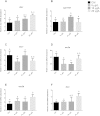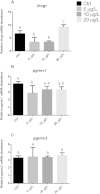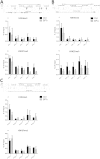BPA-Induced Deregulation Of Epigenetic Patterns: Effects On Female Zebrafish Reproduction
- PMID: 26911650
- PMCID: PMC4766405
- DOI: 10.1038/srep21982
BPA-Induced Deregulation Of Epigenetic Patterns: Effects On Female Zebrafish Reproduction
Abstract
Bisphenol A (BPA) is one of the commonest Endocrine Disruptor Compounds worldwide. It interferes with vertebrate reproduction, possibly by inducing deregulation of epigenetic mechanisms. To determine its effects on female reproductive physiology and investigate whether changes in the expression levels of genes related to reproduction are caused by histone modifications, BPA concentrations consistent with environmental exposure were administered to zebrafish for three weeks. Effects on oocyte growth and maturation, autophagy and apoptosis processes, histone modifications, and DNA methylation were assessed by Real-Time PCR (qPCR), histology, and chromatin immunoprecipitation combined with qPCR analysis (ChIP-qPCR). The results showed that 5 μg/L BPA down-regulated oocyte maturation-promoting signals, likely through changes in the chromatin structure mediated by histone modifications, and promoted apoptosis in mature follicles. These data indicate that the negative effects of BPA on the female reproductive system may be due to its upstream ability to deregulate epigenetic mechanism.
Figures




Similar articles
-
Effects of BPA on female reproductive function: The involvement of epigenetic mechanism.Gen Comp Endocrinol. 2017 May 1;245:122-126. doi: 10.1016/j.ygcen.2016.08.010. Epub 2016 Aug 30. Gen Comp Endocrinol. 2017. PMID: 27591071 Review.
-
Male exposure to bisphenol a impairs spermatogenesis and triggers histone hyperacetylation in zebrafish testes.Environ Pollut. 2019 May;248:368-379. doi: 10.1016/j.envpol.2019.01.127. Epub 2019 Feb 8. Environ Pollut. 2019. PMID: 30818116
-
Bisphenol A as epigenetic modulator: setting the stage for carcinogenesis?Eur J Clin Invest. 2015 Jan;45 Suppl 1:32-6. doi: 10.1111/eci.12362. Eur J Clin Invest. 2015. PMID: 25524584 Review.
-
Bisphenol A in Reproduction: Epigenetic Effects.Curr Med Chem. 2018 Feb 21;25(6):748-770. doi: 10.2174/0929867324666171009121001. Curr Med Chem. 2018. PMID: 28990514 Review.
-
Effects of Dietary Bisphenol A on the Reproductive Function of Gilthead Sea Bream (Sparus aurata) Testes.Int J Mol Sci. 2019 Oct 10;20(20):5003. doi: 10.3390/ijms20205003. Int J Mol Sci. 2019. PMID: 31658598 Free PMC article.
Cited by
-
Histone Methylation-Mediated Reproductive Toxicity to Consumer Product Chemicals in Caenorhabditis elegans: An Epigenetic Adverse Outcome Pathway (AOP).Environ Sci Technol. 2024 Nov 5;58(44):19604-19616. doi: 10.1021/acs.est.4c04061. Epub 2024 Oct 24. Environ Sci Technol. 2024. PMID: 39445662 Free PMC article.
-
Sex-associated protective effect of early bisphenol-A exposure during enteric infection with Trichinella spiralis in mice.PLoS One. 2019 Jul 10;14(7):e0218198. doi: 10.1371/journal.pone.0218198. eCollection 2019. PLoS One. 2019. PMID: 31291264 Free PMC article.
-
Neuro-toxic and Reproductive Effects of BPA.Curr Neuropharmacol. 2019;17(12):1109-1132. doi: 10.2174/1570159X17666190726112101. Curr Neuropharmacol. 2019. PMID: 31362658 Free PMC article. Review.
-
Bisphenol A-induced oxidative damage in the hepatic and cardiac tissues of rats: The modulatory role of sesame lignans.Exp Ther Med. 2020 Jan;19(1):33-44. doi: 10.3892/etm.2019.8193. Epub 2019 Nov 13. Exp Ther Med. 2020. PMID: 31853270 Free PMC article.
-
Next-generation and further transgenerational effects of bisphenol A on zebrafish reproductive tissues.Heliyon. 2018 Sep 15;4(9):e00788. doi: 10.1016/j.heliyon.2018.e00788. eCollection 2018 Sep. Heliyon. 2018. PMID: 30225382 Free PMC article.
References
-
- Rubin B. S. & Bisphenol A. An endocrine disruptor with widespread exposure and multiple effects. J. Steroid Biochem. Mol. Biol. 127, 27–34 (2011). - PubMed
-
- Kang J.-H., Kondo F. & Katayama Y. Human exposure to bisphenol A. Toxicology 226, 79–89 (2006). - PubMed
-
- Crain D. A. et al. An ecological assessment of bisphenol-A : Evidence from comparative biology. Reprod. Toxicol. 24, 225–239 (2007). - PubMed
Publication types
MeSH terms
Substances
LinkOut - more resources
Full Text Sources
Other Literature Sources
Molecular Biology Databases

